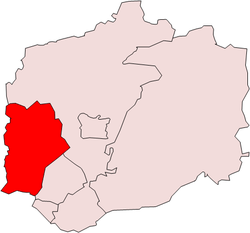Waltham Holy Cross Urban District
| Waltham Holy Cross | |
|---|---|
 The district in 1911 | |
| Area | |
| • 1911 | 11,017 acres (44.58 km2) |
| • 1931 | 11,016 acres (44.58 km2) |
| • 1961 | 10,959 acres (44.35 km2) |
| Population | |
| • 1911 | 6,795 |
| • 1931 | 8,201 |
| • 1961 | 11,655 |
| Density | |
| • 1911 | 0.6/acre |
| • 1931 | 0.7/acre |
| • 1961 | 1.1/acre |
| History | |
| • Origin | Waltham Holy Cross parish |
| • Created | 1894 |
| • Abolished | 1974 |
| • Succeeded by | Epping Forest District |
| Status | Urban district |
| Government | Waltham Holy Cross Urban District Council |
Waltham Holy Cross was an urban district in the county of Essex, England.[1]
History
The large ancient parish of Waltham Holy Cross adopted the Public Health Act 1848 and the Waltham Holy Cross Local Board of Health was formed in 1850.[2] The district of the board included the town of Waltham Abbey as well as the hamlets of Holyfield, High Beach, Sewardstone and Upshire. The district was bounded on the west by the River Lea and contained a large part of Epping Forest.
The local government district became an urban district in 1894.
The district was within the Metropolitan Police District and part of the review area of the Royal Commission on Local Government in Greater London, however it did not form part of the proposed Greater London area,[3] because it was entirely within the Metropolitan Green Belt and had limited connection to the London built-up area.[4] The urban district was abolished by the Local Government Act 1972 on 1 April 1974, becoming part of the non-metropolitan district of Epping Forest. A successor parish was formed at the same time.[5] By resolution of the parish council, the parish was redesignated as Waltham Abbey with the status of a town, and accordingly is now governed by Waltham Abbey Town Council.
Coat of arms
The urban district council was granted a coat of arms on 9 November 1956. The black engrailed cross and four gold cross crosslets on a silver ground come from the arms of Waltham Abbey and the lion's face is from the attributed arms of King Harold Godwinson. The crest above the arms featured a stag for Epping Forest. In the stag's mouth was a seaxe, or distinctive notched sword, from the arms of Essex County Council. A heraldic fountain on the stag's shoulder represented the King George V Reservoir. The colours of the torse wreath and mantling were red and white: the livery colours of both Essex County Council and the City of London Corporation, custodians of Epping Forest.[6] The coat of arms of the urban district council were transferred to Waltham Abbey Town Council by Order in Council in 1974.[7]
References
- ↑ Great Britain Historical GIS / University of Portsmouth, Waltham Holy Cross UD. Retrieved on 2008-02-27.
- ↑ "Waltham Holy Cross: Economic history and local government". A History of the County of Essex: Volume 5. 1966. Retrieved 2008-02-28.
- ↑ Royal Commission on Local Government in Greater London: 1957–1960: Report, 1960, HMSO
- ↑ Sharpe, LJ (1961). The Report of The Royal Commission on Local Government in Greater London.
- ↑ The Local Government (Successor Parishes) Order 1973 (1973 No. 1110)
- ↑ Waltham Abbey Town Council, Civic Heraldry of England and Wales, accessed 28 February 2008
- ↑ The Local Authorities (Armorial Bearings) Order 1974 (1974 No. 869)
Coordinates: 51°36′N 0°06′E / 51.6°N 0.1°E